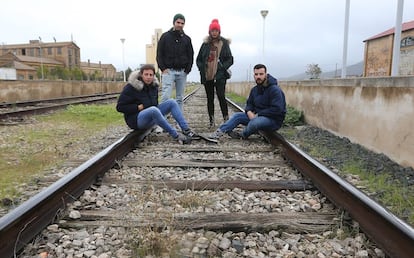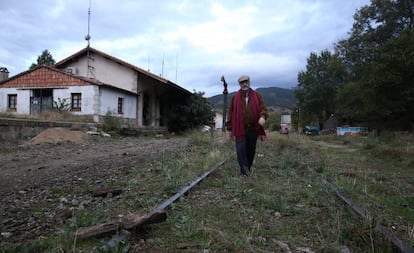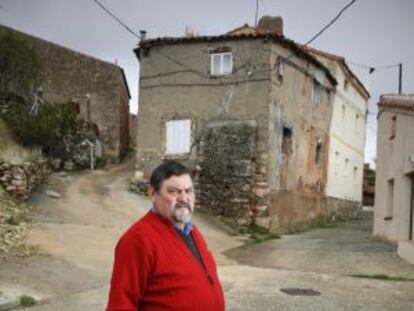Spain’s Extremadura region: “No opportunities and no hope”
More than 400,000 locals in the region live on €700 a month while 13,000 have left in the last five years as promises of a better rail connection fail to materialize

The train in Extremadura goes at three different speeds, according to actor Chema Trujillo – slow, very slow or not at all. It’s a joke from a local, but the truth is that delays, cancellations and even fires are no laughing matter. On October 13, one of the trains heading for Madrid actually ran out of gas.
The 1,072,059 people who live in the western region in Spain are tired of hearing promises that the rail network will be fixed, just as they are sick of being at the bottom of the statistics ladder. Six of the 10 poorest municipalities in Spain are in Extremadura. More than 400,000 locals live on just €700 a month and the younger generation leave as soon as they can – 13,000 of them in the last five years. Its 388 towns are eerily quiet. So what’s going on in Extremadura?
There’s been enough waiting. We want the politicians to come up with the goods
Vale Rodríguez, citizen’s platform Milana Bonita
Zahínos is the poorest town in the whole of Spain. Situated in the province of Badajoz, it smells of coal and damp leaves. The first thing you see as you enter is El Largo, one of its main watering holes. “People are paid from day to day,” says its owner Francisco Guerrero, 49. “But we have to go elsewhere to find work.”
Guerrero charges €1 for a coffee and the same for a small beer. He has no staff and no soccer package for the TV. “I did put on the Madrid-Barça match, of course,” he says. In Zahínos, the average annual income of its 2,806 residents is €10,386, less than half the national average, which is €21,360.
Poverty has gained ground in the region in the last year. According to a report from the State of Poverty in Spain, 44.3% of its inhabitants are at risk of social exclusion. In fact, it is now 25 points higher in the report’s ranking than it was before the economic crisis. Many of the locals have work but they cannot afford at least four of the nine consumer items considered basic by European standards, such as adequate heating for their homes, the ability to meet unexpected costs or a week’s annual vacation.

Zahínos local Manuel Perera, 61, has three children. One has found work away from home, the other is unemployed and the third has a debilitating illness. “I have spent all my life working in Catalonia,” he says. “Now things are looking bad.”
Another Zahínos resident, María Ángeles Sequedo, 21, failed to graduate from high school and has only worked 15 days of her life. She has seen the beach just once. “They don’t want women, not even to pick fruit,” she says. Unemployment affects 45% of young people like Sequedo. “I have a mortgage and I manage thanks to my partner,” she says. “He is paid where he can get work – €45 a day, if he’s lucky.”
The report paints a bleak picture, but the reality is not all negative. There is a broad range of cars, new businesses are opening and fiber optic internet connections are being installed in people’s homes. Jennifer Marín, 30, says, “Maybe it’s because not everything people have is registered.”
Marín studied Work Science in Badajoz and in 2016 she returned to her hometown to open a clothes store. “It’s not bad,” she says. “You don’t need much to live on here. Although it is true that most of the young people leave.”
One of the problems is the local attitude: we limit ourselves, don’t protest much and accept what comes our way
Anthropologist Javier Marcos
Last February, the regional newspaper Hoy ran with this front page: “Every month Extremadura loses 200 young people aged between 20 and 39.” In the report, it stated that more than 12,666 had left since 2012, according to the National Statistics Institute (INE). Fernando Vaca, 29, was among them. He went to London. “There was nothing here for me,” he says. Saúl Barbero, 30, from Caceres felt the same way. Now he is about to open a Telepizza in the province of Salamanca. “There isn’t much opportunity here,” he says. “In my group of friends, there are 25 of us and 20 have left. There’s just bar and restaurant work in the summer. There’s nothing more permanent.”
The Institute of Extremadura Youth describes the situation as “complicated.” According to the institute’s director general Felipe González: “It’s not the same living in a town as living in Madrid. Next year, we are announcing our sixth youth scheme with an investment of €16 million.”
Elena Ruiz, president of the Youth Council, adds: “There are no opportunities and there is no hope.” She and her team drew up a report in 2016 on the request of the regional premier, Guillermo Fernández Vara, from the Socialist Party (PSOE). The conclusion was that Extremadura was not attractive to young people. In a bid to make it more so, the report suggested developing a framework to help set up new businesses.
Nowadays, there are 66,879 businesses in the region, 976 fewer than before the economic crisis. “We are surviving,” says Francisco Javier Peinado, secretary general of the Extremadura Employers association (Crex). “But if a local young person studies and then sees there’s nothing for them, they leave. Never mind the demand for a better rail service, Caceres and Badajoz – 92 kilometers apart – are not even linked by a highway!”

From the transport unions, there are cries for state investment, but do the people of Extremadura feel they might be in any responsible for what is happening? Anthropologist Javier Marcos is one of the 20 experts from various parts of the region who produced the book, What did the people of Extremadura do to get here?. He claims: “It’s not just the fault of Madrid. One of the problems is the local attitude: we limit ourselves, don’t protest much and accept what comes our way. Nowadays, the fat cats are not in the field, they are in the regional government, the university and the banks. There’s nepotism that’s political and geographical. For decades, it’s been noted that the councils are more like family businesses than public entities.”
During the presentation of the book at the Caceres book fair, one of its editors told the Extremadura Post shared a remark made by a customer: “All of us from Extremadura want a subsidy and nobody wants to be a businessman.”
José Manuel Álvarez moved to Extremadura from Uruguay 40 years ago. Having always worked in the power sector, he decided to set up Electromercantil in 2016, which now has 60 workers. “We have the raw material but we don’t know how to exploit the skills,” he says. “The economy is linked to the young and if they leave…”
With the exodus comes the problem of depopulation – a loss of 38,000 people since 2012. Around 11,000 of them have gone abroad and no one comes to replace them – not Spaniards from other regions nor immigrants – here only 2.9% of the population is foreign, which is the lowest figure in Spain. “It is as if you had got rid of 19 small towns in one fell swoop,” says Antonio Pérez, a lecturer of Geographical Analysis at the University of Extremadura. “The future is clear. My students tell me they don’t want to stay.”
Manuel Toro, 24, is an exception. He is a journalist working in Llerena in the south of Extremadura. “I’ve stayed because I’ve found a job doing what I want to do, but I will go to Mérida or Cáceres,” he says.

In Llerena, which has a population of 6,000, there’s a train line with wooden tracks from the 19th century – the oldest in Spain – linking Cáceres with Seville. “I’ve caught it more than 50 times as a student and it’s always late,” says Saúl.
The north of the region was cut off from the north of Spain in 1984 when the national rail network Renfe closed the Plasencia-Salamanca-Astorga line. What’s left is a bad connection to Madrid. Anyone living in Extremadura with a meeting in the capital travels to Madrid the night before. In the past few weeks, there have been flights from Badajoz, thanks to a regional government subsidized deal. But the flight still costs €90 each way and politicians and businessmen believe that a better train connection is what is needed to revolutionize the region and bring it more business, trade and tourism.
Currently, the trip from Badajoz to Madrid costs €51.40 and takes six hours and 37 minutes if it is on time. The same journey is just four hours by car. The Talgo train, which is back on track after eight years, is slightly faster. It takes five hours and eight minutes. That is, of course, in theory. In practice, it always arrives late because none of the region’s 725 kilometers of rail line is electric. Moreover, there’s only one line serving two directions so at some stage one train has to park in a station en route to let the other past.
Former Spanish Prime Minister José María Aznar promised Extremadura a high-speed AVE train in 2002. The latest on this is that it will be ready by 2025. “They are now finally getting on with it. The train that links Madrid with Badajoz will take 30 minutes less by June 2019 due to improvements,” says the region’s Transport Minister Begoña García.
Meanwhile, Vale Rodríguez, the spokesman for the citizen’s platform Milana Bonita, says: “There’s been enough waiting. We want the politicians to come up with the goods.”
A week ago, Public Works Minister José Luis Ábalos visited the region and announced new investment plans. This is the seventh time Extremadura has been promised such investment since 1981. In a gesture of solidarity, Ábalos decided to take the train back to Madrid. Naturally, that day of all days, it was on time.
English version by Heather Galloway.
The famous “vacation of shame”
Fernando Pulido caught a train last October 13 from Plasencia to Madrid. On his ticket, it said he would be in Atocha station at 7.10pm. “I was going to see my family,” he says. “But at 6.55pm they told us that the train would not arrive at its destination. We were in Fuenlabrada!” Fuenlabrada is just 23 kilometers from Madrid.
Furious, Fernando sought out the conductor and was told the train had run out of fuel. “How could that happen?” he says. “Immediate structural plans are needed. It’s tremendous neglect. The least they could do is say sorry.”
Other incidents happened on the same line on October 12, 13 and 14. One stopped in the middle of the countryside due to a technical problem and the 134 passengers were forced to make the rest of the journey by bus. On social networks, the holiday weekend was dubbed “vacation of shame.”
Two top Renfe executives lost their jobs because of the problems. In an interview on the Madrid radio station Cadena SER's Hoy por Hoy program, Renfe President Isaías Táboas said: "Public services can't fail. We have lost the faith that people had in them. It's very serious and we have to say sorry."
Last week, the creation of a Coordinator for Extremadura’s Rail System was announced. “The figures are decisive,” said Public Works Minister José Luis Ábalos during a conference in Mérida. “Of the €170 million tendered for train services between January and September, 97% have been in these last four months by the new government. In 2020, hybrid trains will begin to run in the region.”
Tu suscripción se está usando en otro dispositivo
¿Quieres añadir otro usuario a tu suscripción?
Si continúas leyendo en este dispositivo, no se podrá leer en el otro.
FlechaTu suscripción se está usando en otro dispositivo y solo puedes acceder a EL PAÍS desde un dispositivo a la vez.
Si quieres compartir tu cuenta, cambia tu suscripción a la modalidad Premium, así podrás añadir otro usuario. Cada uno accederá con su propia cuenta de email, lo que os permitirá personalizar vuestra experiencia en EL PAÍS.
¿Tienes una suscripción de empresa? Accede aquí para contratar más cuentas.
En el caso de no saber quién está usando tu cuenta, te recomendamos cambiar tu contraseña aquí.
Si decides continuar compartiendo tu cuenta, este mensaje se mostrará en tu dispositivo y en el de la otra persona que está usando tu cuenta de forma indefinida, afectando a tu experiencia de lectura. Puedes consultar aquí los términos y condiciones de la suscripción digital.
More information
Archived In
Últimas noticias
Most viewed
- Sinaloa Cartel war is taking its toll on Los Chapitos
- Oona Chaplin: ‘I told James Cameron that I was living in a treehouse and starting a permaculture project with a friend’
- Reinhard Genzel, Nobel laureate in physics: ‘One-minute videos will never give you the truth’
- Why the price of coffee has skyrocketed: from Brazilian plantations to specialty coffee houses
- Silver prices are going crazy: This is what’s fueling the rally










































